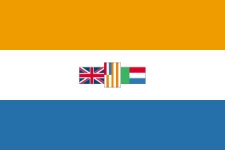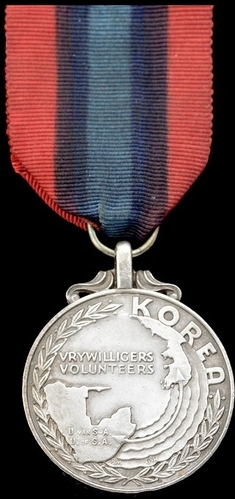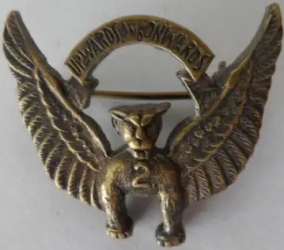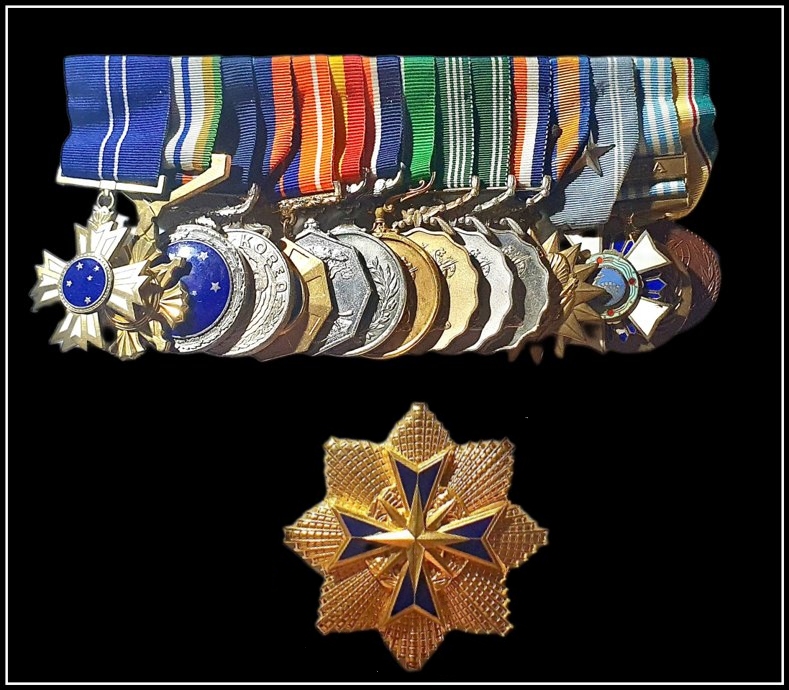

Rim inscription: E23018 A. L. BOTES He served from in Korea from Mar. 29 to Nov. 19, 1953
At the outbreak of the Korean War, the United Nations Security Council passed a resolution calling for the withdrawal of the North Korean Forces. A request was also made to all UN members for assistance. After a special Cabinet meeting on July 20, 1950, the government of the Union of South Africa (Dutch: Unie van Zuid-Afrika; Afrikaans: Unie van Suid-Afrika) announced that a South African Air Force fighter squadron would be made available to support the UN effort.
The 2 (Transvaal) Squadron, known as the “Flying Cheetahs” was formed at Waterkloof in January 1939, flying the Hawker Hartbees.1 Since its creation, it has been involved in every single combat action in which the South African Air Force (SSAF) has taken part.
The majority of the first pilots sent to Korea were highly decorated WWII fighter pilots. Roughly 177 of the 243 officers who served in Korea had WWII experience. As members of the South African Permanent Force are liable for service only within South Africa, service in the Far East was on a voluntary basis only. In calling for volunteers, the response was overwhelming, not only from members of the Permanent Force but from the Citizen Force and from ex-members of the SAAF. South Africa also deployed an Army and Medical Corps contingent, which served as part of the 1st Commonwealth Division. A small liaison staff left for Japan on September 10th. On September 25th, the initial 50 officers and 157 other ranks of 2 Squadron SAAF left Pretoria by train for Durban, from where they set sail for Japan aboard the MV Tjisadane, arriving in Yokohama on November 5th. Upon arrival in Yokohama, Japan, the squadron was moved to Johnson Air Base (Iruma Air Base 入間基地) near Tokyo for training on the F-51D Mustangs supplied by the US Air Force. On the morning of Nov. 19, 1950, Cmdt Theron and Capt. G.B. Lipawsky took off with two USAF pilots to fly the first SAAF combat sortie.
A total of 826 South Africans served during the war, of which there were: 243 Air Force officers (9 individuals did 2 tours), 545 Air Force ground personnel. In addition, there were 23 army officers and 15 other ranks who served primarily with the Commonwealth Division. The South African Air Force’s 2 Squadron became part of the U.S. Air Force’s 18th Fighter-Bomber Wing. In January 1953, the squadron returned to Japan for conversion to the USAF F-86F Sabre fighter planes. The first Sabre mission was flown on March 16, 1953, from K-55 Air Base (Osan) in South Korea. It was the first jet mission flown by the SAAF. On July 8, 1953, the 2 Squadron had its first encounter with Mig-15 fighter planes. In all, the Flying Cheetahs flew 12,405 sorties, 10,373 in F-51D Mustangs and 1,694 in F-86F Sabre jets.
The war ended on July 27, 1953, when the Korean Armistice Agreement was signed. The last South African Air Force members left Korea on October 29, 1953. They are the so-called “Bitter Einders.” The Afrikaans phrase “Bitters Einders” means “those that have endured to the end”. 2
South Africa suffered 36 casualties who were killed in action (including 34 pilots and two ground crew). The SAAF had 8 pilots taken as prisoners of war (including the future Chief of the South African Air Force, General D. Earp). There are 11 South Africans buried in the Korean United Nations Memorial Park 재한유엔기념공원 (在韓유엔記念公園) in Pusan. The squadron had lost 74 of their 94 Mustangs and 5 out of their 22 Sabre jets.
The Commonwealth awarded 2 “Member of the Most Excellent Order of the British Empire (MBE)”, and had 2 “Mentioned in Dispatches (MiD)”.3


There were 797 Union of South Africa Korean (War) Campaign Medals issued. The eligibility dates for the Korea Medal were Sept. 19, 1950 to July 27, 1953. Qualification required one day service in an active duty unit or thirty days total for official tours and inspections. The medals are named in impressed block capitals along the edge. The South African Korea Campaign Medal was issued to “The Flying Cheetahs” and to a small military staff that served with the British Commonwealth Division. The Korea Campaign Medal was instituted by Queen Elizabeth II in 1953. The medal was struck in silver, has a 38 mm diameter and is 3 mm thick. On the obverse, around the edge is a laurel wreath, the left branch spreading from the bottom of the medal to the top, while the right branch is shorter to allow space for the inscription “KOREA”. The center has the words “VRYWILLIGERS” and “VOLUNTEERS”, with outlines of the maps of the Korean Peninsula and South Africa, including South-West Africa. The maps are connected by a line with an arrowhead at each end and five wavy lines. Superimposed on the map of South Africa are the inscriptions “U. van S-A.” and “U. of S.A.” (Union of South Africa). The reverse has the pre-1994 South African coat of arms and Queen Elizabeth II’s royal cipher (E II R) above the coat of arms and the British crown above that. The medals are named on the rim in impressed block capitals. The ribbon is 32 mm wide, with two 6 mm orange edge stripes, two 5 mm wide dark blue inner stripes, and a 10 mm wide light blue stripe in the center.
All 797 South Africans also received the United Nations Medal for the Korean War, all of them in the English language version. All the original medals are named in impressed block capitals along the edge.
On June 30, 1961, the Republic of Korea presented the SAAF with the Order of Military Merit, Taeguk with Gold Star, to the unknown dead of the armed forces of the Union of South Africa.4 In addition, for the Order of Military Merit, the ROK awarded: 2 Ulchi Medals w/Silver Star, 4 Ulchi Medals w/o Star, 5 Chungmu Medals w/Gold Star, 6 Chungmu Medals w/Silver Star, 2 Hwarang Medals w/Gold Star, and 2 Hwarang Medals w/Silver Star. There were 818 (ROK) Korean War Service Medals (6.25 사변종군 기장) awarded. It also awarded a Republic of Korea Presidential Unit Citation for exceptional meritorious service and heroism on Nov. 1, 1951.
The American decorations earned by the South Africans include: 3 Legions of Merit, 50 Distinguished Flying Crosses (1 with Oak Leaf Cluster), 2 Silver Stars, 40 Bronze Stars, 176 Air Medals (152 with Oak Leaf Clusters), and 1 Soldier’s Medal. Mr. Edward T. Wailes (1903 – 1969), the United States Ambassador to South Africa, presented 2 Squadron with a Presidential Unit Citation on August 3, 1956. The citation read “for extraordinary heroism in action against the armed enemy of the United Nations”.
There is a Korean War Memorial is located in at the Union Building in Pretoria, South Africa. The names of the 38 South Africans who were killed in action are listed on the monument, as well as the names of the 8 who are missing in action. The Korean War Memorial in Johannesburg is inside the Air Force Museum. Within the museum, there is a wall plaque with the names of 34 fallen South African pilots. On Sept. 29, 1975, Korea erected a monument dedicated to the South Africans who served during the Korean War. It was officially opened on December 22, 1975. The memorial honors the contributions of South Africa, displaying a plaque etched with the names of 36 soldiers who gave their lives during the Korean War. The monument is located at 1-7 Yongyong-dong, Pyeongtaek-si, Gyeonggi-do.
A. N. Saayman, P11185
This group includes: a South African Campaign Medal for Korea; a South African Permanent Force Good Service Medal; a United Nation’s Medal for Korea, and the Korean War Service Medal, mounted for wear. I do not know if all of these items were the property of the original recipient.




The Permanent Force Good Service Medal was instituted by the Republic of South Africa in 1961 when South Africa became a republic. It replaced the Union Medal. It was awarded to Permanent Force members of the South African Defense Force for eighteen years of service and good conduct. The Permanent Force Good Service Medal is a pendant with a scalloped edge and a raised rim, 38 mm in diameter and 3 mm thick at the rim and struck in silver, depicting the pre-1994 South African Coat of Arms. The reverse is inscribed “VIR LANGDURIGE DIENS EN GOEIE GEDRAG” and “FOR LONG SERVICE AND GOOD CONDUCT” and has a raised rim and decorated ribbon suspender, similar to those on the obverse. The medals and ribbon suspenders were minted separately and soldered together. The medal number was stamped or engraved at the bottom of the rim. The ribbon suspender is decorated with proteas and leaves. A clasp could be awarded after thirty years of service. The clasp was struck in silver and is 32 mm wide, with the South African Coat of Arms embellished in the center and with a hole at each corner to enable it to be sewn to the ribbon. When ribbons only are worn, recipients of the clasp would wear a silver button on the ribbon bar, embellished with the South African Coat of Arms. It was replaced by the John Chard Medal. The ribbon is 32 mm wide, with three bands of orange, white and blue, repeated three times, the outer orange and blue bands each 4 mm wide and the seven inner bands all approximately 3½ mm wide. Orange, white and blue are the colours of the pre-1994 national flag. It is identical to the ribbon of the Union Medal. The Permanent Force Good Service Medal was discontinued in 1975, when it was replaced by a new set of three good service medals, they being the Good Service Medal in Gold, Silver, or Bronze.
Lt. General Denis John Earp SSA SD SM SOE (1930 – 2019), former Chief of the South African Air Force (1984 to 1988)
In 1951, Lt. Gen. Earp, then a 2nd Lieutenant, was shot down and taken POW in Korea on Sept. 27. He was commanding a flight of four planes, detailed to undertake an early morning (first light) recce. The No. 2 plane developed engine trouble and was forced to return to base (K10 Chinhae). No. 4 plane took over position No. 2. Earp instructed the flight to bomb a bridge at BT7981, and shortly thereafter they rocket strafed a village at BT7884, where a 50 Caliber weapon began firing at them. After Earp pulled out of his dive, he noticed his aircraft was streaming engine coolant (glycol). He informed his No. 2 and No. 3 that he was heading South, and they were to form up on him and switch over to the “D” channel, which they did.5 He reported his situation to the US rescue organization and continued flying for about 30 minutes until a small fire started in the cockpit. He bailed out successfully and landed on the side of a hill at CT0717. His aircraft hit the ground at CT0815, where it exploded on impact. 2nd Lieutenant Earp was captured, taken as a POW and released with 6 other SAAF pilots on the cessation of hostilities in 1953.
His medal group includes: Southern Cross Decoration (For Outstanding Service); South African Police Star For Outstanding Service {SAAF worked in close co-operation with the South African Police, thus the Police decoration}; Southern Cross Medal (For Outstanding Service); South African Campaign Medal for Korea (1951-1953); Pro Patria Campaign Medal for the so-called “Border War”; South African Campaign Medal for the Cross Border Operations in Angola; South African General Service Medal (GSM) for internal operations; 40 year Medal for Long Service and Good Conduct (LSGC) Medal; 30 year (Gold) LGSC Medal; 20 year (Silver) LSGC Medal; 18 year LSGC Medal (awarded before 1975 when the qualification terms were amended to 10, 20, 30 & 40 year Long Service medals); U.S. Air Medal with Oak Leaf Cluster; South Korean Order of Military Merit, Chungmu Class with Silver Star; United Nations Medal for Korea; South Korean “Korean War Service Medal”. At the bottom is the Star of South Africa, (Gold) Breast Star (SSA also known as SSAG). Although not shown, he was also decorated with the Order of Clouds and Banner (2nd Grade with Grand Cordon) in 1987 by the Republic of China (ROC), with the Gran Cruz Al Merito Aeronautico from Chile and with the Al Merito Miltar from Paraguay.
In 1986, during his tenure as the Chief of the South African Air Force, he was able to revisit Korea.
There is a whole series of video interviews with Lt. Gen. Earp at the Korean War Legacy Foundation.

Picture courtesy of Col. (Retired) Dirk Louw.
For additional information on the contributions of the “Cheetahs” in the Korean War, see: The South African Korea Medal Role by Colin R. Owen, Chimperie Publication, 1982.
Footnotes:
- The H.G. Hawker Hartbees (which is also widely described as the ‘Hartebeeste’ or ‘Hartbeest’) was based on the Hawker Audax army cooperation aircraft, with modifications to suit the South African Air Force. It should be noted that the name ‘Hartbees’ was the designation used on the aircraft drawings, contracts and production license, which justifies its use here.
- The term Bittereinders (or irreconcilables) originates from a faction of Boer guerrilla fighters, who continued to resist the forces of the British Empire in the later stages of the Second Boer War (1899–1902) with many of them refusing to sign the Vereeniging Peace Treaty in 1902. In essence: “Never Say Die.” Those who did surrender were called the “hens-oppers” because they put their hands up. This is not a complimentary term, to put it mildly.
- The 2 recipients who were Mentioned in Dispatches during the Korean War, are entitled to wear a Bronze Oak Leaf on the ribbon and ribbon bar of the Korea Medal.
- In 2015, initial planning was started to build a Memorial to South Africa’s Unknown Dead.
- When an aircraft would go down, the pilot would key their radio to D channel (Dog channel). This would send out a continuous signal on a specific frequency. Three radio monitoring stations were then used to triangulate and pinpoint an exact location of the signal. A helicopter(s) could then be dispatched to rescue the downed airman(men).
